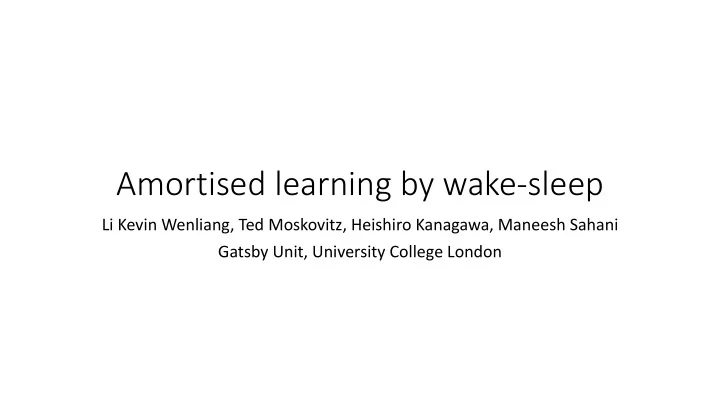

Amortised learning by wake-sleep Li Kevin Wenliang, Ted Moskovitz, Heishiro Kanagawa, Maneesh Sahani Gatsby Unit, University College London
direct max likelihood 𝜾 upda update i te in V n VAE AE amor amortis tised ed lear learning ning consis isten tent! t! biased… simple le, direct! ect! Intractable… approximate ximate agnost gnostic t ic to o model s model str tructur ucture and type and ty pe of of Z Z gives giv es bett better er tr trained ained models models ,
Least square regression gives conditional expectation
How to estimate ? • define • then • In practice, draws and solve Algorithm: Issues: } 1. 𝑨 𝑜 , 𝑦 𝑜 ∼ 𝑞 𝜄 • sleep is high dimensional 2. find ො by regression • computing for all sleep samples can be slow 3. 𝑦 𝑛 ∼ } wake 4. update 𝜄 by ො (𝑦 𝑛 )
How to estimate more efficiently ? • define • suppose we estimate with kernel ridge regression, then auto-diff is an estimator of by kernel ridge regression Theorem : if and the kernel is rich, then is a consistent estimator of
Amortised learning by wake-sleep 1. 𝑨 𝑜 , 𝑦 𝑜 ∼ 𝑞 𝜄 consis isten tent! t! 2. kernel ridge regression simple le, direct! ect! 3. 𝑦 𝑛 ∼ 4. update 𝜄 by 𝑦 𝑛 = ∇ 𝜄 መ 𝑔 𝜄 (𝑦 𝑛 ) Assumptions: Non-assumptions: • easy to sample from 𝑞 𝜄 • posterior • ∇ 𝜄 log 𝑞 𝜄 (𝑦, 𝑨) exists • structure of 𝑞 𝜄 2 • true gradient is ℒ 𝑞 • type of 𝑎 ,
consis isten tent! t! Experiments • Log likelihood gradient estimation simple le, direct! ect! • Non-Euclidean latent • Dynamical models • Image generation • Non-negative matrix factorisation • Hierarchical models • Independent component analysis • Neural processes
Experiment 1: gradient estimation
Experiment II: prior on the unit circle 𝑨 ∈
Experiment III: dynamical model
Experiment IV:sample quality
Experiment IV: downstream tasks
amor amortis tised ed lear learning ning consis isten tent! t! simple, le, direct! ect! , Thank you!
Recommend
More recommend